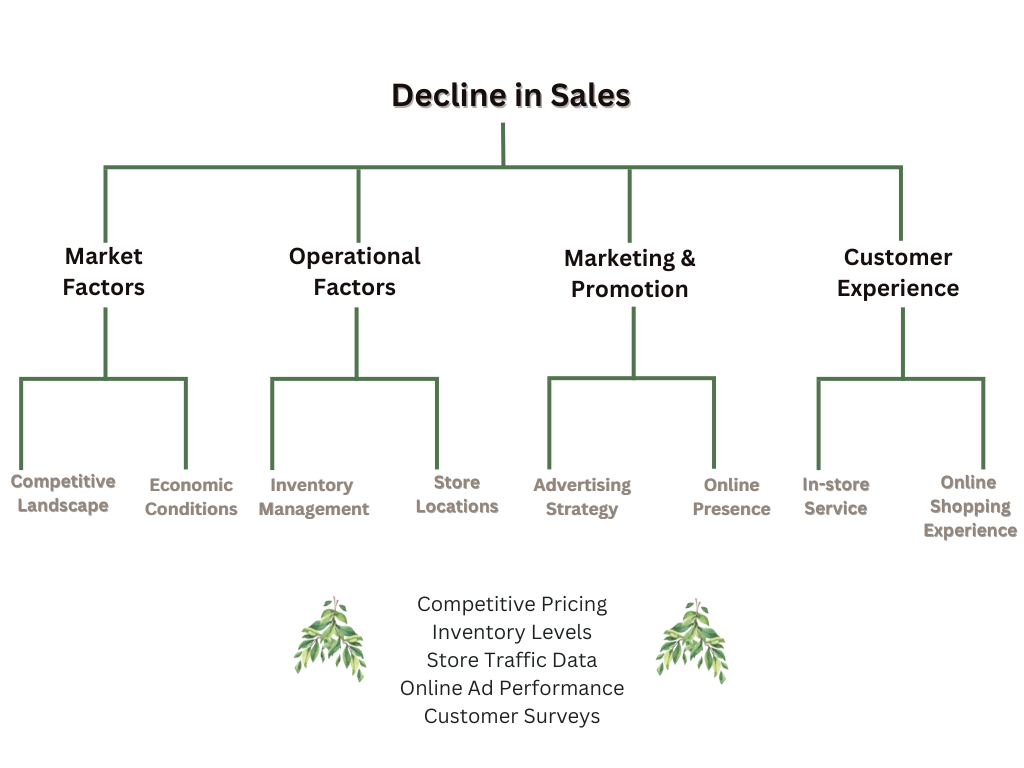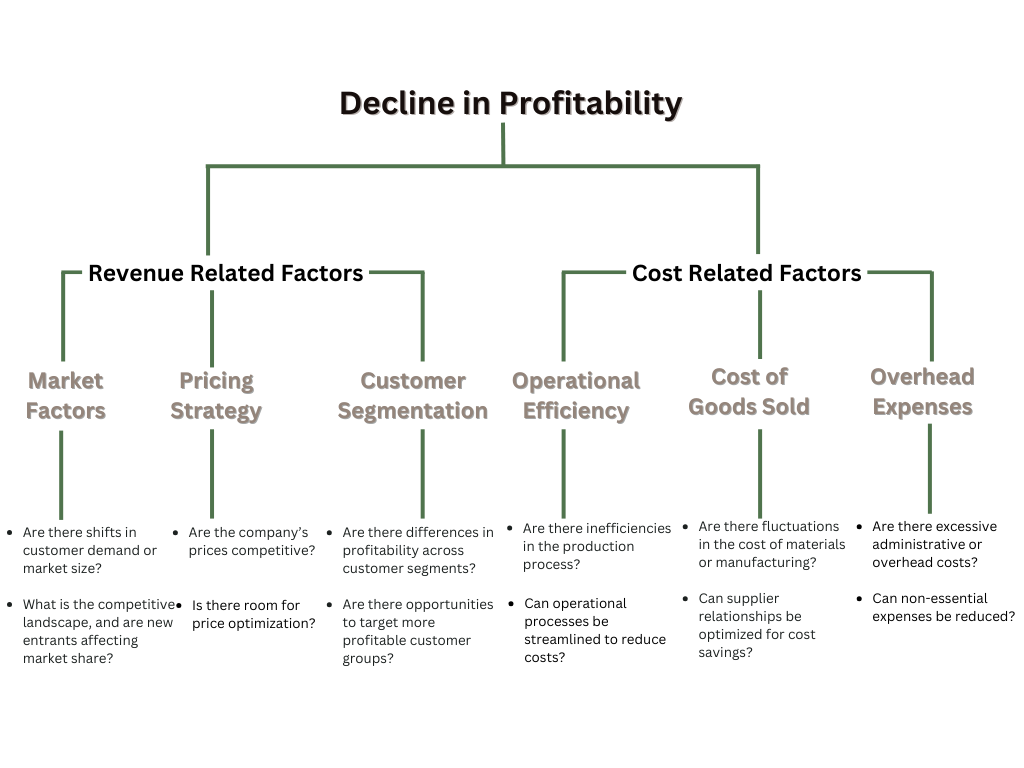Case interviews are the crucible through which aspiring consultants (whether it’s in business or other fields) prove their mettle. These high-stakes simulations demand not just quick thinking but a structured, methodical approach to problem-solving. And that’s where the Issue Tree Framework comes into play.
This article will dive deep into practical applications, sharing real-life case interview examples and demonstrating how to build and use an Issue Tree to crack complex business problems.
Whether you’re a fresh graduate embarking on your consulting journey or a seasoned professional looking to enhance your problem-solving toolkit, this post has something valuable in store.
The Issue Tree
The Issue Tree, also known as a Logic Tree or Hypothesis Tree, helps break down complex problems into smaller, more manageable components, making it easier to analyze, identify solutions, and communicate findings. Here’s how it works.

Structure of an Issue Tree:
An Issue Tree is made up of four different ‘levels’, starting from the tippy-top of the canopy (the main objective) and going all the way down to the leaves (the small issues associated with the obective).
Here’s a brief summary for each of the levels and what they represent:
- Top-Level Problem or Objective:
At the top of the tree, you define the primary problem or objective you’re trying to address. This should be a concise statement of the main issue.
- Main Branches or Themes:
Below the top-level problem, you create branches that represent the main themes or factors contributing to the problem. These are often 2-5 high-level themes that encompass the primary issues.
- Sub-Branches:
For each main branch, you further break down the problem into sub-branches. Sub-branches can be categorized hierarchically and can continue to branch out as needed.
- Leaves:
The leaves of the tree represent specific, detailed issues, questions, or components of the problem. Each leaf should be a granular, answerable question or issue.
Steps to Create an Issue Tree:
Like with the four levels, there are four steps to create an issue tree for analyzing case interviews:
Step #1: Define the Problem
Start by clearly defining the main problem or objective you’re addressing. It should be specific and actionable.
Step #2: Identify Main Branches:
Think about the primary themes or categories that are contributing to the problem. What are the major factors or areas that need to be analyzed?
Step #3 : Break Down Main Branches:
For each main branch, ask how it can be further broken down. What subcategories or components contribute to that theme? Continue this process until you reach a level of detail that allows for analysis and problem-solving.
Step #4: Ask Focused Questions:
For each leaf of the tree, ask precise and focused questions. These questions should be answerable and should lead to actionable insights or solutions.
Benefits of the Issue Tree Framework:
- Structured Problem-Solving:
The Issue Tree provides a structured and organized approach to problem-solving. It helps ensure that all relevant factors are considered.
- Clarity and Communication:
It makes complex problems more understandable and facilitates clear communication with team members, clients, or stakeholders.
- Analysis and Prioritization:
It allows for a systematic analysis of the problem and helps prioritize areas that need attention.
- Hypothesis Generation:
Issue Trees can also be used to generate hypotheses and test various scenarios and solutions.
Case Interview Examples & Applications
Example 1
Suppose you’re working on a case related to declining sales for a retail company. Your Issue Tree might look like this:

By using this Issue Tree, you can systematically explore and analyze various factors contributing to declining sales and develop actionable solutions for each component of the problem.
Example 2:
Let’s walk through another example of how to use the Issue Tree Framework to analyze a case interview scenario. Suppose you’re presented with a case about a company experiencing a significant decline in profitability. You want to systematically analyze the factors contributing to this problem.
Here’s how you can apply the Issue Tree:
- Define the Problem:
Top-Level Problem: Decline in Profitability
- Identify Main Branches:
Think about the primary themes or categories that are contributing to the decline in profitability. In this case, you identify several main factors:
Main Branches:
Revenue Related Factors
Cost Related Factors
- Break Down Main Branches:
For each main branch, break down the problem into sub-branches or subcategories. These sub-branches represent specific areas that contribute to the decline in profitability.
Revenue Related Factors:
Market Factors
Pricing Strategy
Customer Segmentation
Cost Related Factors:
Operational Efficiency
Cost of Goods Sold
Overhead Expenses
- Ask Focused Questions:
For each leaf of the tree, ask specific and focused questions to identify key issues or components contributing to the decline in profitability:
Market Factors:
Are there shifts in customer demand or market size?
What is the competitive landscape, and are new entrants affecting market share?
Pricing Strategy:
Are the company’s prices competitive?
Is there room for price optimization?
Customer Segmentation:
Are there differences in profitability across customer segments?
Are there opportunities to target more profitable customer groups?
Operational Efficiency:
Are there inefficiencies in the production process?
Can operational processes be streamlined to reduce costs?
Cost of Goods Sold:
Are there fluctuations in the cost of materials or manufacturing?
Can supplier relationships be optimized for cost savings?
Overhead Expenses:
Are there excessive administrative or overhead costs?
Can non-essential expenses be reduced?
In other words, your issue tree should look something like this:

By systematically analyzing each of these factors, you can identify the root causes of the decline in profitability and develop specific recommendations to address the issues. This structured approach not only helps you pinpoint the problem areas but also ensures that you consider all relevant factors in your analysis.
In a real case interview, you would communicate your thought process as you work through the Issue Tree, and you might continue to break down sub-branches further to arrive at actionable insights and recommendations.
Further Resources for Case Interviews
Here are some recommended external sources that providesexamples for you to practice:
- Oliver Wyman case interview guide (by IGotAnOffer)
- Enterprise Resource Management practice case (Deloitte website)
- Consultant mock interview video (Bain website)
- Written case interview tips (Bain website)
- Footloose written case (by Deloitte)